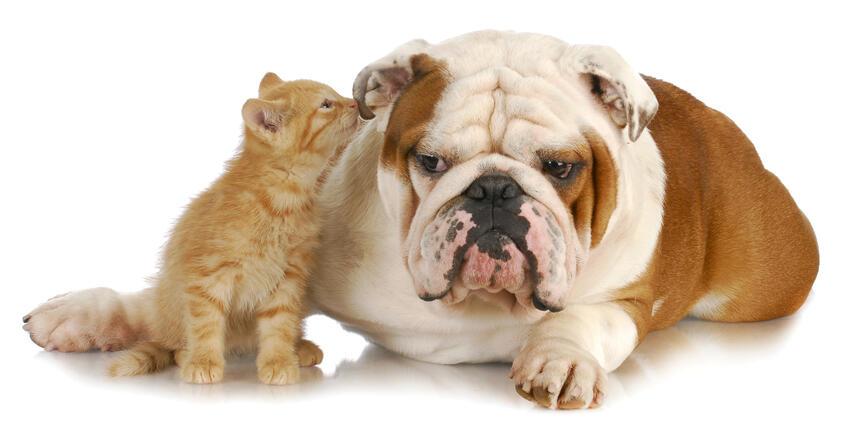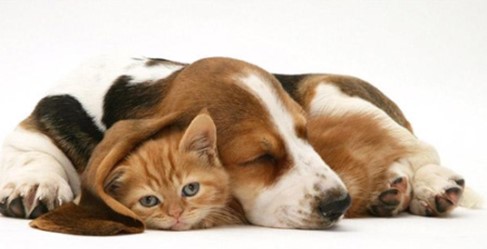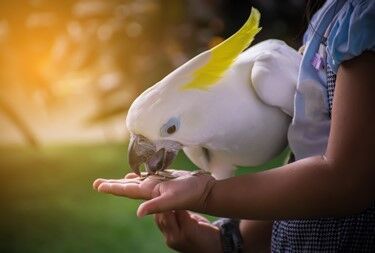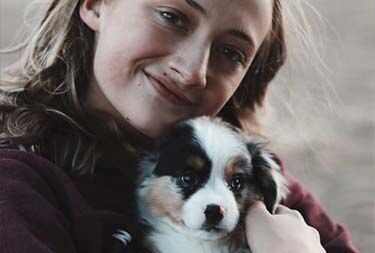The number of registered
animals is growing every day
Published: Apr 24, 2020

It often happens that dog lovers also dream of the soothing purrs of a cat, or vice versa, cat enthusiasts may decide that it’s time for a dog. How can we ensure that our plans, instead of the anticipated idyll, do not turn into endless battles and a tense atmosphere due to the four-legged companions interacting like "cats and dogs"? To take the right steps, it is essential to first understand the dynamics governing the relationships between these two species.
Does the phrase "like cats and dogs" which metaphorically implies broad antagonism, have its basis in the true relationships between these species, or is it merely a rhetorical figure unsupported by facts? Where do the antagonisms between cats and dogs originate, influencing their behavior and mutual attitudes, and what factors might mitigate these predispositions? Is this alignment with nature and, most importantly, is it desirable from the perspective of respecting the natural needs of the animals?
To answer these questions, we should start by delving into the behavior of cats and dogs, which is fundamentally different and likely stems from traits inherited from distant ancestors. Dogs are descendants of naturally social wolves, while domestic cats are descended from wildcats and Nubian cats, known for their individual, solitary lifestyle. Due to this heritage, dogs have developed as social animals, seeking human interaction and being dependent on it, preferring the company of humans, responding to every signal from their owner, and eager to cooperate. In contrast, cats are perceived as individualists, showing much more restraint in expressing emotions, forming relationships, and not responding to every signal from humans. They decide whether to engage or ignore attempts to establish a relationship from the owner.
The perception of pack relationships and territoriality also differs between dogs and cats; cats do not exhibit tendencies towards rivalry or fighting for a position in the pack, whereas dogs have this ingrained in their nature and value familiar corners, rituals, and feel best in their own home. A change of location introduces chaos into a cat’s life, often ending in disappearance.
For a dog, the owner is more important than the surroundings, as the presence of the owner provides a sense of security, and more important than where they are, is that they are together!
From the preliminary analysis of behavioral traits, it can be concluded that the psychological needs of these most common companions of humans are extremely different. However, this does not mean that communication between a dog and a cat is impossible. There are several factors that influence whether there will be harmony, conflict, or avoidance policy between representatives of these species.
Besides their differing natures, the language through which all animals communicate with the world plays a crucial role in the communication between cats and dogs, namely…
Misunderstandings, as some behaviorists claim, mainly arise from the fact that seemingly similar gestures have completely different meanings for each species.
The body language of cats and dogs, through which these quadrupeds communicate with their peers, may not be correctly understood and interpreted by each other. The most common and characteristic examples of different meanings of the same gestures are:
New situations, circumstances, or people, as well as stressful situations, trigger different reactions in the mentioned species. A dog typically shows lively excitement and interest in such situations, while a cat will respond with reservation, withdrawing to examine the new situation carefully.
What is play and a sign of interest for a dog, a cat might interpret as aggression and lead to a defensive stance, fleeing, or even attacking. An example of this behavior is wagging the tail, which a cat might react to with flight; the usual result is a chase by the dog, which will treat such behavior as an invitation to play.
So what can be done to most effectively contribute to building correct, and perhaps even friendly, relationships between our behaviorally conflicting pets, and what factors should be considered to support the development of good bonds?
Instincts in cats and dogs mature during their development – the younger the kitten or puppy, the weaker these instincts are, making the companion of a different species not perceived as an enemy.
Between eight and twelve weeks of age, puppies and kittens are in a phase of heightened socialization, also called the critical period in development, and exhibit the greatest adaptability and learning ability, as well as inherent instinctive curiosity and cognitive needs, which foster positive relationships, shared play, and treating each other as companions. First contacts at this age will bring the most desired results.
In summary – the younger the animals, the smoother their positive relationships will develop. Similarly, it should be noted that adult animals may not always accept each other and often require increased efforts and time to get used to one another.
Ideally, both animals should come to you at as young an age as possible, preferably close in age, and from day one, they should not compete for the owner's attention, space, or food, but rather be companions in shared play.
It is worth gathering information about the socialization of the animal that is to come to our home, its predispositions, or any experiences with other animal species and any unusual behaviors.
Often, the first meeting is the deciding factor for the type of relationship that will exist between the four-legged roommates (at least in the coming weeks), and as some behaviorists claim, it is even the key to success in their mutual relations.
During the first steps of the newcomer in the new home, we must ensure that the new resident is introduced to the new environment without harming the already settled pet. We need to realize that the established four-legged resident feels like the master of the situation because they are at home, and any newcomer will initially be perceived as an intruder. Thus, we can expect a "snub" from them, which should not discourage us. Ensure the comfort of the "old" resident without significantly disrupting their space or rituals; the food bowl should remain in place as should the bedding. It is the "new" one who will adapt to the existing situation, and it will surely be much easier for them than changing the habits of the settled animal.
First Steps:
If you have successfully navigated the first step, which is introducing the dog and cat to each other and establishing a connection, you can say that "the first hurdles are behind us." However, the work to ensure the relationship blossoms fully is still ahead!
What mistakes should be avoided to support the proper development of relationships between the pets?
Remember to divide your attention equally between both animals; the "old" resident of the house now needs your attention more than ever to avoid associating the arrival of the new resident with losing their privileges and status. Ensure not to neglect affection or reduce the time spent with the old resident in favor of the new one; from now on, your attention must be divided between the two. It is essential to ensure that both animals are treated with equal care and love.
The animals are still learning about each other and establishing boundaries for their interactions. Until their relationship stabilizes, it will require observation and preventive measures from you. For the next few weeks:
Regardless of whether there is an age difference or length of residence in your home between the animals, it is necessary to provide them with separate comfort zones and independence where they can rest or simply be alone. This is essential for maintaining the sense of security of the animals, allowing them to retreat to a place that belongs solely to them in case of danger or just fatigue. Animals living together, even with excellent understanding between them, should have separate beds, bowls, and spaces to ensure a sense of individuality and personal space.
Ideally, allocate separate rooms or distant parts of the house for the cat and dog.

Common sense, proper socialization, and dedication from the owner can work wonders, and the question of a cat getting along with an amstaff or other breeds unfairly perceived as "aggressive" dogs is entirely possible and quite frequent. Notably, dogs often accept only their "own" cat, and show no tolerance towards outsiders, ready to chase away any visitor who accidentally wanders onto their territory.
However, some dogs, due to the predispositions resulting from their breed, have a reputation for being friendly towards cats and easy to integrate with them. Leading breeds in this regard include:
However, this list should be approached with the same seriousness as the so-called "Aggressive Dog List," because in reality, almost everything is in the hands of the owner!
These are representatives of hunting breeds that possess a strong primal instinct to track and chase small game, which may include cats.
Dogs and cats are often susceptible to the same bacteria, pathogens, or parasites (although there are also diseases specific to each species and safe for others).
Therefore, before introducing a new four-legged friend into the home, remember to address trivial but crucial health issues and ensure that:
Encouraging friendship between a dog and a cat may be a challenge, but it is certainly worth the greatest efforts because what wouldn’t one do for friendship and love!
Dogs and cats have different body languages and behaviors, which leads to misunderstandings and conflicts between them.
For example, wagging a tail in dogs signifies happiness, while in cats it indicates irritation.
Yes, with proper introduction and understanding of their differences, dogs and cats can live together peacefully.




Marking animals with a microchip is the most durable, effective and completely safe method of quick and reliable identification. Every transponder (chip) has a unique number which enables instant identification of the animal and its owner, helping them reunite faster. However, it is important to remember that a chip is just a transponder with an encoded number. It is not a tracking device and contains no data about the animal or the owner! Therefore, in order to identify a chipped dog or cat, it is necessary that a microchip be registered in a national marked animal database...
Read moreIn today's world, responsibility for animal care has become not only a priority for their owners but also a societal issue. One of the most important tools in ensuring animal safety is the chip database. It allows for the quick and efficient recovery of lost pets, which is crucial for protecting their health and well-being.
The introduction of microchipping has significantly improved the effectiveness of efforts to locate lost animals, reducing stress for both owners and their four-legged friends. Registration in the chip database is increasingly required by local regulations, further highlighting the importance of this technology in ensuring comprehensive care for animals.